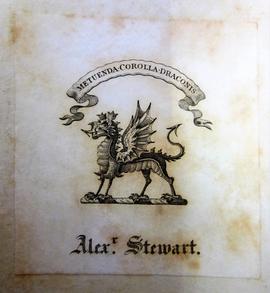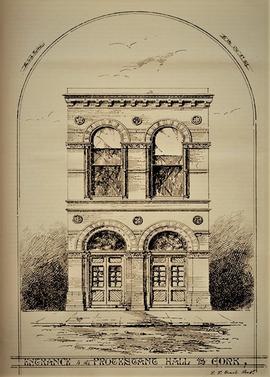Papers of Ard Mhuire Capuchin Friary, County Donegal
- IE CA DL
- Subfonds
- 1796-2017
Part of Irish Capuchin Archives
In March 1930 the Capuchin Franciscans purchased Ards House near Creeslough in County Donegal. The Order procured Ards House and its 100-acre demesne from the Irish Land Commission who had acquired the estate from its previous owners, the Stewart-Bam family. The Ards estate, situated on a sheltered inlet of Sheephaven Bay, had a long history. The picturesque and mostly forested estate, located about fourteen miles from Letterkenny, was acquired by the Wrays, Williamite settlers from Yorkshire, in about 1700. The original house at Ards was constructed by the Wray family in 1710. In the eighteenth century, William Wray was described as ‘a celebrated figure, eccentric and autocratic, though kind and generous’. As a consequence of his extravagance and accumulating debts, William Wray was forced to sell his estate at Ards for £13,250 to Alexander Stewart (1746-1831) in 1781. Stewart was a younger brother of Robert Stewart, First Marquess of Londonderry (1739-1821), and an uncle of the renowned statesman, Robert Stewart, Viscount Castlereagh (1769-1822). Alexander Stewart served as High Sheriff of County Donegal from 1791-2, was a Member of Parliament from 1814-8, and was an owner of extensive properties at Ards, Doe Castle, Dunfanaghy, and in Letterkenny in County Donegal. He carried out extensive renovations to the Wray estate and towards the end of his life rebuilt Ards House into a two-storied Georgian mansion with an elaborate façade and expansive interior public rooms. The house was designed by John Hargrave (c.1788-1833) and was completed in about 1830. By the early twentieth century ownership of the Ards estate had passed to Lady Ena Dingwall Tasca Stewart (1885-1945) who inherited the property from her grandfather in 1904. In 1910, Lady Ena Stewart married Sir Pieter Canzius Blommestein Bam (1869-1928), a South African soldier, politician and businessman. From this point on, the property was known as the Stewart-Bam estate. Ards House and its 2,000-acre estate remained in the family’s possession until its acquisition by the Irish Land Commission in 1926.
The Commission assigned the northern portion of the estate to the Department of Lands for afforestation. This portion of the estate, covering over 1,200 acres, is now managed by Coillite, the state-run forestry body, as Ards Forest Park, which is an important tourist and public amenity in the locality. The remaining portion of the former Stewart-Bam estate was divided among tenants. Ards House and its demesne of over 100 acres was left unoccupied and gradually fell into disrepair. About this time, the Irish Capuchins were seeking a suitable location for a novitiate for the education of friars and students. In March 1930 the Capuchins purchased Ards House from the Irish Land Commission for £4,500. Extracts from the minute book of the Irish Capuchin Provincial Council provides some further detail:
'7 February 1930
It was decided that, the permission of the Bishop of Raphoe having been obtained for a foundation in his Diocese, to purchase Ards House and a portion of the demesne from the Irish Land Commission and to apply to Rome for sanction.
5 March 1930
It was decided that the purchase of Ards House in the Diocese of Raphoe for a canonical foundation be completed immediately and that provision be made for heating, lighting, and furnishing it and that Fr. Colman Griffin OFM Cap. be appointed Guardian of the new foundation, which will be known as Ard Mhuire Friary, dedicated to the Immaculate Conception of the Blessed Virgin Mary'.
The first community in the newly established Ard Mhuire Friary consisted of the above-mentioned Fr. Colman Griffin OFM Cap., who was joined by Fr. Peter Kelleher OFM Cap. and Fr. Andrew Carew OFM Cap. Ards House, while solidly built (some of its stone walls were nearly three feet thick), was apparently not as commodious as exterior appearance would lead one to believe. It was also evident that the interior layout and facilities would require significant adaption to suit the needs of a religious community. An article on the history of Ard Mhuire provides the following details on the challenges facing the friars upon their arrival in Donegal:
'Fr. Colman, recalling their arrival, said they found the place under a mantle of snow (it was mid-March 1930). In every way, it was a rather dismal, depressing scene. Ards House had been vacant for a long time, the only occupiers being Paddy and Mrs O’Brien, who had shared the care-taking chores. In the intense cold, the absence of heating and lighting offered a cheerless prospect. The solitary concession was a fire in one room. They had brought bedding, but settling down in unaired, damp-ridden rooms posed a hazard to health. … First priority was an internal restructuring to comply with the needs of community life. What had been a room for dancing was converted into an oratory where Mass was celebrated. Gradually, the transformation took place, two massive mantle pieces which had to be removed were later erected in Glenveigh Castle. It was the same outside. The expansive grounds had been neglected for years, resembling a wilderness; roads and paths were blocked by fallen trees. … Progress was satisfactory enough to have the first novices brought to Ard Mhuire in January 1931. Bit by bit, the community, supported and encouraged by the local people, changed the former manor house into a friary that lacked none of the essentials'. (CA DL/6/22).
Ard Mhuire Friary quickly developed as focal point for the education of Capuchin friars for the priesthood as the Order’s novitiate and later as a house of theology. It was at Ard Mhuire where Capuchin clerical students spent their final four years of training before ordination. The entire course of their training took at least eight years from the completion of secondary school studies, with a year-long novitiate, three to four years of philosophy scholarship at university and a final four years of theological studies at Ard Mhuire. In the 1950s an increase in the number of vocations made it necessary to find more space at Ard Mhuire. It also became evident that the former Ards House would require extensive renovations. A serious fire in December 1944 had caused significant damage to the old mansion (see CA DL/3/10) and it was clear that the building would need substantial repair work. The condition of the old friary had by this point deteriorated considerably. The roof was developing cracks and the oldest part of the building, the elaborate façade, was physically crumbling. Three separate plans were drawn up for proposed alterations to the existing building, but all proved unsatisfactory. A decision was therefore made to build a new friary and house of studies along with a public church able to accommodate three hundred worshippers. Designs for the new buildings by the architect, James Rupert Boyd Barrett (c.1904-1976), were approved and the new friary and church were formerly opened on 13 November 1966. The old friary building was demolished shortly afterwards. The new buildings cost over £200,000 to complete. Money for the project was gathered through missions in the United States as well as subventions from the Order’s leadership in Rome. There were also several bequests and further donations. A collection in the diocese of Raphoe raised a total of £16,000. The new house of studies at Ard Mhuire provided accommodation for forty students, eight priests and six lay brothers. The new chapel was designed to meet the demands of the liturgical requirements of the Second Vatican Council with provision made for the con-celebration of Mass and an extensive sanctuary specifically designed for ordination ceremonies.
In September 1972 the Irish Capuchins decided to centralize theological studies and transfer their novices to Dublin. In the wake of the Second Vatican Council, it was felt that the Ard Mhuire was too remote and that friars studying for new forms of ministry should live in locations which offered more scope for and access to different kinds of social and pastoral work. This change had obvious implications for the future of Ard Mhuire which would now have a vastly diminished community of friars. During the forty-one years in which theological studies continued in the Donegal friary, one hundred and ninety-two students were ordained to the priesthood. Many of these friars went on to minister in overseas missions, mainly in the United States and in Africa where the Irish Capuchins had established custodies. Concerns were expressed by the then Bishop of Raphoe, Anthony McFeely (1909-1986), that Ard Mhuire would be closed and that the Capuchins would leave Donegal. At the Capuchin Provincial Chapter in 1973, it was decided to explore alternative pastoral and social uses for the Ard Mhuire foundation. In the summer of 1974, Ards Friary opened as a retreat house for use by both religious and lay communities. More attention was also paid to the use of the friary’s grounds as a public amenity. The old walled gardens of the former estate and the adjoining forest walks had been open to the public since the Capuchins acquired Ards House in 1930 and from 1972 the friary itself was opened up for various uses including social events for local lay organisations, outreach and fundraising conferences, and functions for charitable and religious purposes. In 2002 a new reception area and coffee shop were added. At the end of 2006 changes were made in relation to the management of the conference and retreat centre which ensured a greater role for the clergy of the diocese of Raphoe. Extensive renovations were made to the centre from 2007 to 2013 with the costs borne by the local diocese. Today, Ard Mhuire serves as the retreat and conference centre of the diocese of Raphoe. Priests and religious from many congregations and dioceses continue to make use of the centre for retreats. Ards Friary also offers conferences amenities for lay organizations with an emphasis on facilitating periods of rest, relaxation, reflection, prayer and vacation.
Collection Content
The collection consists of records relating to the Capuchin Franciscan community in Donegal and in particular to the foundation known as Ard Mhuire Friary (or Ards Friary) located near Creeslough in the county. Most of the records post-date 1930 when the Capuchins acquired ownership of Ards House, the former Stewart-Bam mansion, which they re-named Ard Mhuire and transformed into a theological seminary. The fonds includes legal records relating to the acquisition of Ards House from the Irish Land Commission, financial and business records, and photographic records assembled by individual members of the Capuchin community residing at Ard Mhuire. The collection also contains records relating to physical alterations to the Ard Mhuire foundation including correspondence, architectural plans and financial records relating to the construction of a new friary and house of studies on the existing site in the 1960s. Other records in the collection relate to Ard Mhuire’s use (particularly from 1972 onward) as a retreat and conference centre in the diocese of Raphoe. The fonds also contains historical research, newspaper clippings, photographic records and ephemera compiled by various Capuchin friars relating to the history of the locality including material on the previous owners of Ards House in the eighteenth and nineteenth centuries. Much of this historical research was amassed by Fr. David Kelleher OFM Cap. (1912-1995) who spent nearly sixty years of his ministry as a Capuchin friar at Ard Mhuire.


